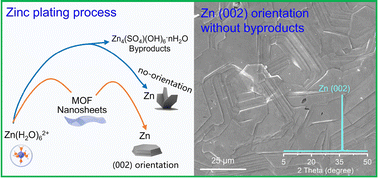MOF nanosheets as ion carriers for self-optimized zinc anodes†
Abstract
Aqueous rechargeable metal batteries are promising for electric grid storage owing to their low cost and intrinsic safety. However, poor anode reversibility hinders practical application due to the chaotic metal deposition present as dendrites and its susceptibility to corrosion caused by water. The chaotic deposition originates from the coupling of hydrated metal ions with the inhomogeneity of the electric field. Hence, we first proposed the concept of “ion carriers” to decouple the ion flux from the electric field. By adopting dynamic and recyclable metal organic framework nanosheets as Zn2+ carriers to hold, transport and horizontally constrain Zn2+ ions, a robust, predictable, and conformal Zn2+ ion deposition is achieved. The zinc anode therefore undergoes self-optimization in both morphology and orientation during cycling. The selective (002) deposition of Zn leads to the strongest (002) texture up to date, along with a byproduct-free surface. Consequently, high cycling stability of the Zn anode can be achieved in both Zn||Zn symmetric cells (6900 h) and full cells (6000 cycles with 90% capacity retention). This “ion carriers” concept uniquely solves the critical issues associated with the Zn anode and could potentially be extended to other rechargeable metal anodes.



 Please wait while we load your content...
Please wait while we load your content...